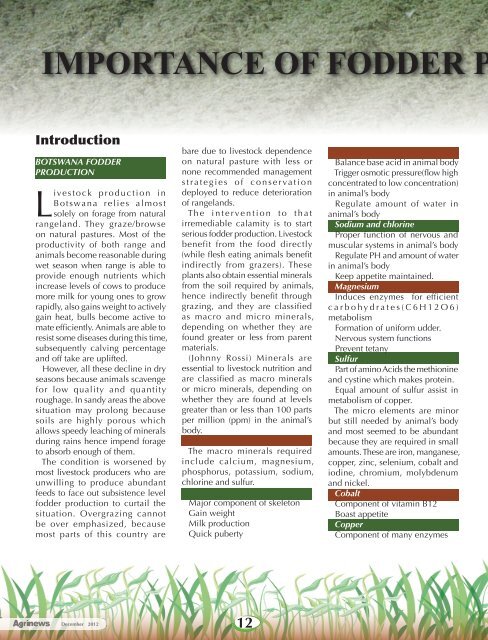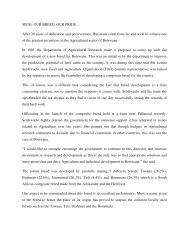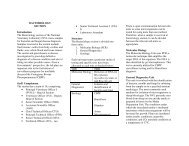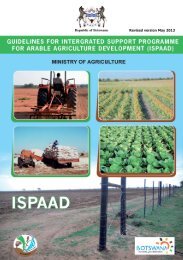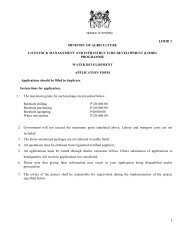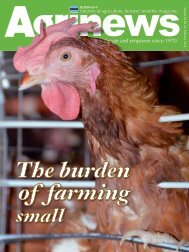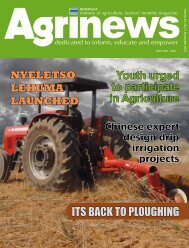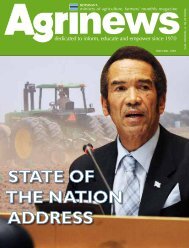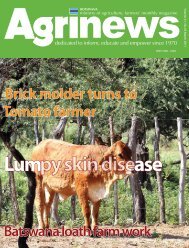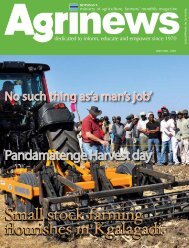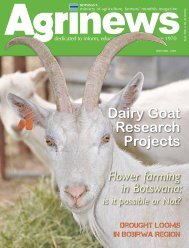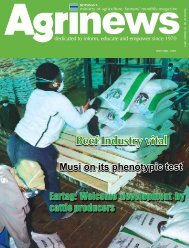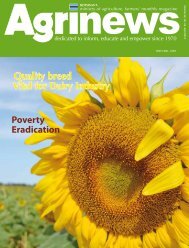Agrinews December 2012 - Ministry of Agriculture
Agrinews December 2012 - Ministry of Agriculture
Agrinews December 2012 - Ministry of Agriculture
- No tags were found...
You also want an ePaper? Increase the reach of your titles
YUMPU automatically turns print PDFs into web optimized ePapers that Google loves.
IMPORTANCE OF FODDER PRIntroductionBOTSWANA FODDERPRODUCTIONLivestock production inBotswana relies almostsolely on forage from naturalrangeland. They graze/browseon natural pastures. Most <strong>of</strong> theproductivity <strong>of</strong> both range andanimals become reasonable duringwet season when range is able toprovide enough nutrients whichincrease levels <strong>of</strong> cows to producemore milk for young ones to growrapidly, also gains weight to activelygain heat, bulls become active tomate efficiently. Animals are able toresist some diseases during this time,subsequently calving percentageand <strong>of</strong>f take are uplifted.However, all these decline in dryseasons because animals scavengefor low quality and quantityroughage. In sandy areas the abovesituation may prolong becausesoils are highly porous whichallows speedy leaching <strong>of</strong> mineralsduring rains hence impend forageto absorb enough <strong>of</strong> them.The condition is worsened bymost livestock producers who areunwilling to produce abundantfeeds to face out subsistence levelfodder production to curtail thesituation. Overgrazing cannotbe over emphasized, becausemost parts <strong>of</strong> this country arebare due to livestock dependenceon natural pasture with less ornone recommended managementstrategies <strong>of</strong> conservationdeployed to reduce deterioration<strong>of</strong> rangelands.The intervention to thatirremediable calamity is to startserious fodder production. Livestockbenefit from the food directly(while flesh eating animals benefitindirectly from grazers). Theseplants also obtain essential mineralsfrom the soil required by animals,hence indirectly benefit throughgrazing, and they are classifiedas macro and micro minerals,depending on whether they arefound greater or less from parentmaterials.(Johnny Rossi) Minerals areessential to livestock nutrition andare classified as macro mineralsor micro minerals, depending onwhether they are found at levelsgreater than or less than 100 partsper million (ppm) in the animal’sbody.MacromineralsThe macro minerals requiredinclude calcium, magnesium,phosphorus, potassium, sodium,chlorine and sulfur.Calcium and phosphateMajor component <strong>of</strong> skeletonGain weightMilk productionQuick pubertyPotassiumBalance base acid in animal bodyTrigger osmotic pressure(flow highconcentrated to low concentration)in animal’s bodyRegulate amount <strong>of</strong> water inanimal’s bodySodium and chlorineProper function <strong>of</strong> nervous andmuscular systems in animal’s bodyRegulate PH and amount <strong>of</strong> waterin animal’s bodyKeep appetite maintained.MagnesiumInduces enzymes for efficientcarbohydrates(C6H12O6)metabolismFormation <strong>of</strong> uniform udder.Nervous system functionsPrevent tetanySulfurPart <strong>of</strong> amino Acids the methionineand cystine which makes protein.Equal amount <strong>of</strong> sulfur assist inmetabolism <strong>of</strong> copper.The micro elements are minorbut still needed by animal’s bodyand most seemed to be abundantbecause they are required in smallamounts. These are iron, manganese,copper, zinc, selenium, cobalt andiodine, chromium, molybdenumand nickel.CobaltComponent <strong>of</strong> vitamin B12Boast appetiteCopperComponent <strong>of</strong> many enzymes<strong>December</strong> <strong>2012</strong>126


